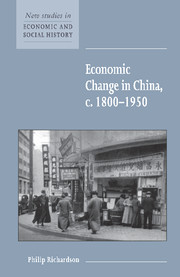Book contents
- Frontmatter
- Contents
- List of maps
- Acknowledgements
- Note on references
- Guide to pronunciation
- Dynastic chronology
- Weights and measures
- Map 1: China: provinces and cities
- Introduction
- 1 Analytical frameworks
- 2 The eighteenth-century legacy and the early nineteenth-century crisis
- 3 Growth and structural change
- 4 Foreign trade and investment
- 5 Industry: traditional and modern
- 6 Agriculture
- 7 The state and the economy
- 8 Conclusion: the legacy of the past
- Bibliography
- Index
- New Studies in Economic and Social History
- Previously published as Studies in Economic and Social History
- Economic History Society
4 - Foreign trade and investment
Published online by Cambridge University Press: 05 June 2012
- Frontmatter
- Contents
- List of maps
- Acknowledgements
- Note on references
- Guide to pronunciation
- Dynastic chronology
- Weights and measures
- Map 1: China: provinces and cities
- Introduction
- 1 Analytical frameworks
- 2 The eighteenth-century legacy and the early nineteenth-century crisis
- 3 Growth and structural change
- 4 Foreign trade and investment
- 5 Industry: traditional and modern
- 6 Agriculture
- 7 The state and the economy
- 8 Conclusion: the legacy of the past
- Bibliography
- Index
- New Studies in Economic and Social History
- Previously published as Studies in Economic and Social History
- Economic History Society
Summary
For Mao Zedong China's modern history only began with the forced opening to more systematic foreign influence that followed the Opium War [54 vol. II: 309]. It is difficult to deny that foreign trade and investment represented powerful catalysts for change or that each continued to play a central role in China's economic modernisation. The extent, consequences and desirability of those contributions, however, remain contentious. Whatever the net effect of foreign trade and investment on the economy – and the weight of opinion has clearly moved towards a more positive outcome – it is clear that it was the product of a complex set of interactions. Trade and investment served simultaneously to stimulate and to restrain the domestic economy and to strengthen as well as to undermine the position of particular participants in that economy.
It is important to stress at the outset that the relationship between the foreign influence and China's economic modernisation should not be seen exclusively in ‘impact-response’ terms. An inherently dormant, stagnating China did not simply respond – or fail to respond – to a dynamic West representing the only force for change. Rather, foreign trade and investment flowed through, and became part of, an existing and evolving commercial system. Chinese merchants, producers and entrepreneurs shaped and reacted to a set of commercial opportunities and challenges – opportunities and challenges which increasingly included a foreign dimension.
- Type
- Chapter
- Information
- Economic Change in China, c.1800–1950 , pp. 40 - 53Publisher: Cambridge University PressPrint publication year: 1999



